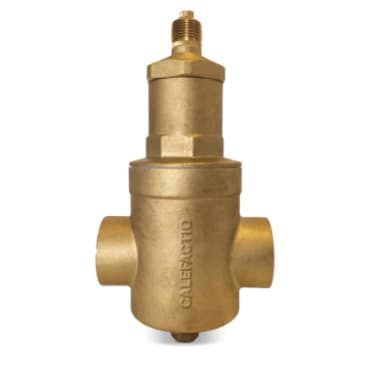
CALEFACTIO CXT-075SC 3/4 SWT BRASS COMPACT AIR SEPARATOR
Product Details
Attributes
Features
Resources
Calefactio Air Separator, CAL-X-TRACT Series, 3/4 in Nominal, C Connection, 150 psi, 32 to 250 deg F, 50 % Maximum Percentage of Glycol, 6 gpm Flow Rate, Brass, 6-7/8 in H x 3-5/8 in W
Calefactio Cal-X-Tract air separators are equipped with a brush-type coalescing media, a calvent automatic air vent and designed with an oversized housing leading to a very high-efficiency. Their function is to take air out of hydronic heating systems, allowing a better energetic performance while reducing the costly maintenance frequency. Their sturdy design allows to maintain their efficiency for whole duration of the system's lifetime.
- Equipped with calvent automatic air vent
- Anti-clogging vent (the head is designed to stay dry and clean, reducing the risks of clogging)
- A drain port is installed at the bottom of the separator
- Brush-type coalescing media to catch the finest micro bubbles without affecting the flow
- Reduce the risk of pump cavitating and rust by oxygen
- Improve the system's efficiency
Product Details
Calefactio Air Separator, CAL-X-TRACT Series, 3/4 in Nominal, C Connection, 150 psi, 32 to 250 deg F, 50 % Maximum Percentage of Glycol, 6 gpm Flow Rate, Brass, 6-7/8 in H x 3-5/8 in W
Calefactio Cal-X-Tract air separators are equipped with a brush-type coalescing media, a calvent automatic air vent and designed with an oversized housing leading to a very high-efficiency. Their function is to take air out of hydronic heating systems, allowing a better energetic performance while reducing the costly maintenance frequency. Their sturdy design allows to maintain their efficiency for whole duration of the system's lifetime.
Attributes
Features
- Equipped with calvent automatic air vent
- Anti-clogging vent (the head is designed to stay dry and clean, reducing the risks of clogging)
- A drain port is installed at the bottom of the separator
- Brush-type coalescing media to catch the finest micro bubbles without affecting the flow
- Reduce the risk of pump cavitating and rust by oxygen
- Improve the system's efficiency
